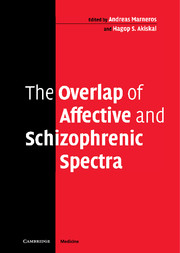Book contents
- Frontmatter
- Contents
- List of contributors
- Preface
- 1 The paradigma of overlapping affective and schizophrenic spectra: schizoaffective conditions
- 2 The overlapping of the spectra: overlapping genes and genetic models
- 3 The continuum of psychosis and its genetic basis
- 4 Functional psychoses: molecular-genetic evidence for a continuum
- 5 State- and trait-related deficits in sustained attention in bipolar disorder: are there any overlaps with schizophrenia?
- 6 The concept of schizoaffective disorder: utility versus validity and reliability – a transcultural perspective
- 7 Phenomenological approaches to the schizoaffective spectrum
- 8 Clinical course of schizoaffective disorders
- 9 Depressive syndromes in schizophrenia
- 10 The overlapping of the spectra: brief and acute psychoses
- 11 Overlapping of the spectra: physical comorbidity between schizophrenia and affective disorders
- 12 The overlapping of the spectra suicide
- 13 Biological treatment of schizoaffective disorders
- 14 Psychological therapies and schizoaffective disorders
- Epilogue: The interface of affective and schizophrenic disorders: a cross between two spectra?
- Index
10 - The overlapping of the spectra: brief and acute psychoses
Published online by Cambridge University Press: 02 September 2009
- Frontmatter
- Contents
- List of contributors
- Preface
- 1 The paradigma of overlapping affective and schizophrenic spectra: schizoaffective conditions
- 2 The overlapping of the spectra: overlapping genes and genetic models
- 3 The continuum of psychosis and its genetic basis
- 4 Functional psychoses: molecular-genetic evidence for a continuum
- 5 State- and trait-related deficits in sustained attention in bipolar disorder: are there any overlaps with schizophrenia?
- 6 The concept of schizoaffective disorder: utility versus validity and reliability – a transcultural perspective
- 7 Phenomenological approaches to the schizoaffective spectrum
- 8 Clinical course of schizoaffective disorders
- 9 Depressive syndromes in schizophrenia
- 10 The overlapping of the spectra: brief and acute psychoses
- 11 Overlapping of the spectra: physical comorbidity between schizophrenia and affective disorders
- 12 The overlapping of the spectra suicide
- 13 Biological treatment of schizoaffective disorders
- 14 Psychological therapies and schizoaffective disorders
- Epilogue: The interface of affective and schizophrenic disorders: a cross between two spectra?
- Index
Summary
Introduction
Brief and acute psychoses – as differentiated from schizophrenia and affective disorders – have long intrigued psychiatrists. Their nosological allocation has been a matter of debate. The World Health Organization (WHO) tried to solve this problem by creating the ICD-10 category F23: “acute and transient psychotic disorders” (ATPD). The ATPD is defined as a psychotic disorder of acute onset (within two weeks) and of limited duration (not longer than three months). For a diagnosis of ATPD, major affective disorders, organic disorders, and schizophrenia have to be ruled out. The creation of this category represented an attempt not only to define and operationalize such psychotic conditions, but also to integrate some national concepts such as the cycloid psychoses of German psychiatry, the bouffée délirante of French psychiatry, the psychogenic psychosis of Scandinavian psychiatry, the atypical psychosis of Japanese psychiatry and the remitting or good-prognosis schizophrenia of USA psychiatry into one single category (Marneros and Tsuang, 1986; Marneros et al., 2000; Pillmann et al., 2000; 2001; Marneros and Pillmann, 2004). The DSM-IV provides the category of brief psychotic disorder (BPD). A diagnosis of BPD requires the presence of delusions, hallucinations, disorganized speech, or grossly disorganized or catatonic behavior, with a duration of at least one day but less than one month and eventual full return to premorbid functioning.
- Type
- Chapter
- Information
- The Overlap of Affective and Schizophrenic Spectra , pp. 182 - 206Publisher: Cambridge University PressPrint publication year: 2006



